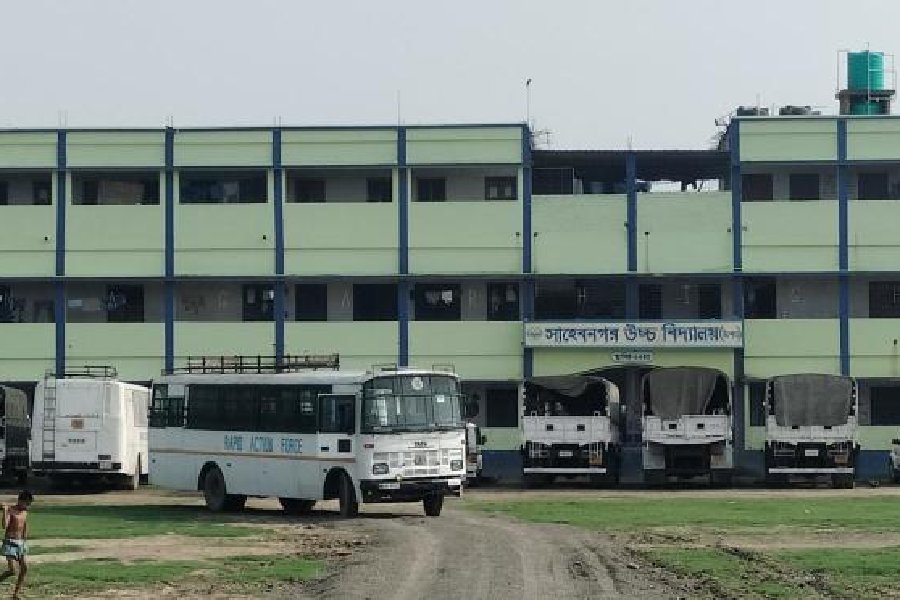 |
| A Neapolitan Mastiff and a Great Dane on the grounds of Bhayrav Kennels in Barasat |
Buying chicken-flavoured chew sticks or fruit-flavoured shampoo for the dog may take just a walk around the corner these days in Calcutta but if he takes ill, an attempt to find an ambulance to ferry him to the hospital will just raise a laugh.
Michael Liu, owner of champion Boxers and Dobermans for over a decade, guffaws on being asked about ambulances for dogs. “When you don’t have proper medical care, how can you expect an ambulance? Pets are not considered important here.”
Even as pet parlours and accessory shops for them are mushrooming in the city — even some petrol pump stores and chemists stock dogfood these days — basic needs of domesticated animals in Calcutta are severely neglected.
Untrained trainers
Owners gladly hand their loved ones to trainers twice a week hoping they will learn the meaning of “sit” and “stay” (Indians love to teach their dogs English), but the quality of trainers is a question mark.
Many trainers simply take the dog for a walk and get him to clear his bowels on the roadside. “In Delhi or Mumbai, you have groomers trained in institutes abroad. A mobile grooming parlour has been started in Mumbai by an acquaintance who trained in Sydney. Here all the grooming parlours do is bathe and snip,” frowns Partha Sekhar Chatterjee, international dog show judge and breeder.
Lack of proper equipment can have severe consequences. “As most parlours don’t have nail grinders, they end up cutting the quick, the soft part under the nails containing blood vessels and tender nerve endings. This leads to a lot of bleeding,” he says.
Playtime
 |
 |
| A dog creche in the city and (below) the pet burial ground near Thakurpukur. Pictures by Aranya Sen and Sanat Kumar Sinha |
Dogs lack open space where they can romp about, without being shouted at by morning-walkers. Kavita Guha, wife of Garden High School rector Indranath Guha, has no place near her Alipore home to take her Golden Retriever to. “Bhombol was refused entry on the National Library premises, nor is he allowed into the Agri-Horticultural Society garden or Victoria Memorial. I feel scared to take him to the Maidan as strays there can attack him.” So, Guha sometimes takes Bhombol all the way from Alipore to the school premises after classes give over. “My friends in Delhi and Bangalore do not face this problem.”
Medical blues
The dog falling ill can be the beginning of a nightmare for the owner. Good vets are rare; good vets — and bad vets — are rarely on time; there is hardly a hospital for animals within reach.
“We phoned the vet many times when my Great Dane was on his deathbed. The vet said he would come, but finally didn’t, saying he was stuck in heavy rain,” says Cherie Tikader, a Class XI student of Salt Lake School.
It’s not merely the callous veterinary. When their pets fall ill, many don’t know where to take them. Diksha Seth, a resident of Outram Street, is afraid to take her Lhasa Apso to a clinic. “Most pet clinics look so shabby I’m afraid Snuggles will catch some infection,” she wrinkles her nose.
Surgery, particularly eye surgery, is a problem. “Most vets lack confidence about surgery and try to make do with medicine. A dog with cataract has less chance of cure in Calcutta than even Ludhiana. Isn’t it a shame when human cataract surgery is so routine?” asks Chandrasekhar Sarkar of North Calcutta Kennel Club.
And for other pets, like birds, the search for facilities is more arduous.
The largest hospital for animals is the government-aided facility in Belgachhia. It is well-equipped, attests Dr Goutam Mukherjee, vet and t2 columnist. It has X-ray machines, both portable and fixed, a USG machine, an automated blood and urine analyser, among other things. The equipment is worth more than Rs 2 crore.
This is an exception. The regular pet clinic may not be fitted even with an X-ray machine. A Salt Lake pet-owner, for instance, has to go all the way to Paikpara, a good 40 minutes away, to get the facility.
Dr Chandan Lodh, head of the department of veterinary medicine, ethics and jurisprudence of the West Bengal University of Animal and Fishery Sciences in Belgachhia, which also runs a clinic, agrees. The centre treats dogs, cats, birds and even the odd mongoose and monkey.
“We get around 50 cases a day. This proves the dearth of good clinics,” says Dr Lodh. “The regular pet clinics cannot afford the kind of equipment we have.”
How many pet-owners can manage to go to Belgachhia every time, or on time, asks Dr Mukherjee. “There are so few laboratories that we have to depend on pathological facilities for human beings,” he complains. Fortunately, the parameters for pathological tests for dogs are similar to human beings. But vets have to interpret X-rays on their own.
As for an ambulance with oxygen and drugs, there is none. Saviour Pets Institute, a Santoshpur facility, has two pick-up vans that work from 8am to 10pm only for its own patients. Compassionate Crusaders Trust has a pick-up facility from noon to 5pm.
Lack of emergency services is a huge gap. “Private facilities like Saviour Pets Institute and Ashari, on the Bypass, do not offer 24-hour treatment,” says Dr Mukherjee. The Belgachhia hospital has an emergency ward but it functions from 8am to 8pm.
Money matters
Why is caring for animals, and pets, such a tough job in Calcutta? The reason is a mix of economics and attitude towards animals. “Spending power on pets is very low in Calcutta. While vets can easily charge Rs 200 to 250 in cities like Delhi or Bangalore, here vets are available for Rs 50-100,” says Dr Saurabh Shekhar, regional sales manager, north and east of Mars International, which sells the popular Pedigree brand of dogfood.
Medical facilities are hit by the lack of a steady clientele. This plagues even a procedure as vital as blood infusion. Moitri Veterinary Clinic near Lake Market, one of the better-equipped outfits in town, did try to import blood grouping kit once. A German company was ready to send the kit, but no less than 100 units at a time and each kit cost Rs 1,200. “How many people can afford Rs 1,200 just on blood grouping?” asks Kishore Ganguly of Moitri.
In these circumstances, grooming, less cosmetic for pets than humans, with procedures such as flea treatment, trimming of hair or paring of nails, suffers even more. This is proved by the Paws experience. The Ballygunge pet shop, which had opened its Salt Lake branch with much fanfare last year, has had to down shutters. “People care about pets in Calcutta but when it comes to shelling out cash, they back out,” says owner Shantanu Mitra.
Last goodbye
Even the last journey of pets is fraught with indignity.
“Our German Shepherd died at a late hour. None of the burial grounds were open. So we had to bury her in a field nearby,” says homemaker Priti Basu. Others end up paying the garbage man to dispose of the body.
Another dog of the Basus is buried in Namanusher Samadhi near Thakurpukur, a good hour away from their east Calcutta home. “We would like to go over to his tombstone on his birthdays but it’s just so far,” she complains.
Many do not mind the distance and space is filling up. Tarun Bhusan Guha, president of Nikhil Banga Kalyan Samity, which runs the burial ground, says they have 280 graves with tombstones and only have space for 120 more.
Compassionate Crusaders Trust runs a burial ground called Karuna Kunj, in South 24-Parganas near Bibirhat, which, unlike Namanusher Samadhi, has a hearse. “We reuse a plot after a year by when the body disintegrates,” says Debasis Chakrabarti of the trust.
Arijit Mukherjee, cinematographer and avid pet lover, has filed papers for registration of a Dog Owners and Lovers Association, whose first task will be to set up an incinerator. “It will cost us Rs 18.5 lakh but we can raise the funds. All we need from the authorities is land,” says the owner of six dogs.
Things are already looking up in another area. Perhaps because people travel much more today, creche facilities in the city are improving.
Home truths
Tity Das, a former handler, has been housing pets at his Deshapriya Park home for about 30 years. “I have separate cages for dogs and cats in my two-storeyed home. Owners leave a diet chart and I feed the animal accordingly.”
But he is wary of birds. If they take ill they die too quickly, making them risky boarders.
Breeder Partha Sekhar Chatterjee keeps dogs at his Gutiarisharif farmhouse, en route to Canning. “I have an aquarium, an aviary and a swimming pool.” But it takes about Rs 1,500 to transport the pet to and fro.”
Some institutionalised facilities are coming up. Saviour has a creche to keep 25 animals at a time. Paws, at Ballygunge Circular Road, can take in a maximum of six dogs. “We are overbooked during the vacations and the rest of the year we have around 50 per cent booking. We want to increase the number of our enclosures to 10 after the Pujas,” says owner Mitra.
Bhayrav Kennels claims to have capacity for over 200 dogs. The catch is it is in Barasat. “Our creche has fields, ponds and hillocks. Creches in the city measure their area in sq ft, we measure ours in acres,” says proprietor Rajesh Kumar Singh. It gets around five dogs a month.
 |
But many pet owners still stay away from family holidays. “When my husband and I wanted to visit Tirupati last year I went alone while he stayed back with our Spitz. Then I returned and looked after him while my husband went to Tirupati,” says Jayashree Nair of Salt Lake.
Some creches can be harmful. “When my cousin left her Spitz at a creche the dog returned with fleas!” says Cherie.
It is not easy to be a caring pet owner or animal lover in the city. Perhaps a clue to the reason lies in what Arijit Mukherjee was told when he approached the chairman of Bidhannagar Municipality Biswajiban Majumdar for the incinerator. “He laughed on my face. He said they can barely take care of people so dogs were a far cry.”
That is a sad truth. Though Mukherjee is now trying to speak to mayor Bikash Ranjan Bhattacharyya.










